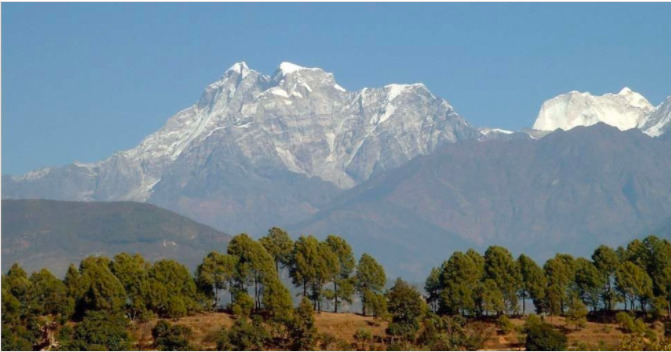
Nepal’s Chure region, which comprises the “youngest mountains in the world” is a critical biodiversity habitat and the main watershed for the country’s plain and lowland areas. Over 5 million people live in the area, and most of them depend on the land for their livelihoods – largely based on agriculture and forest-related goods and services.
But that dependency currently comes at a cost. The “young” soils of Chure are fragile, meaning they have low resistance to erosion and are particularly vulnerable to degradation. And, mostly due to locals’ high dependency on fuelwood, fodder and litter, the region has been continuously deforested for the past few decades at a rate of 1.3 percent, and its biodiversity is steadily deteriorating. That degradation is affecting livelihoods, and food insecurity has become a key issue for many residents.
However, a large proportion of people in the region traditionally practice more sustainable methods of working with the land – a number of which come under the rubric of agroforestry, a system whereby agriculture and pasturelands are integrated with trees to yield a range of social, economic and environmental benefits.
While agroforestry has only recently gained major international attention for its efficiency in conserving natural resources alongside improving livelihoods, it is already relatively well-known in Nepal, which is one of the few countries that has a stand-alone national agroforestry policy that aims to promote and commercialize the approach further.
In that context, a group of researchers from the Center for International Forestry Research (CIFOR), Germany’s University of Göttingen and Dresden University of Technology, have released a new study exploring current agroforestry practices in the Bakaiya rural municipality of Makawanpur District – a particularly ecologically-vulnerable area, which is prone to landslides due to deforestation. The research also explored the prospects of agroforestry as an approach that could be scaled up in order to boost the resilience of both the ecosystem and local communities.
The researchers carried out five focus group discussions, 10 key informant interviews and 100 household surveys. They found that three farm-based agroforestry systems (of a possible 12) were practiced in the municipality: agri-silvicultural systems (agricultural crops with forest crops); agri-horti-silvicultural systems (agricultural crops with garden crops and forest crops) and agri-silvi-pastoral systems (agricultural crops with forest crops and grasses for grazing animals).
However – unsurprisingly for a region that is relatively remote and in which most people have only a primary level of formal education – locals did not tend to think of their practices in those terms, and there was little in the way of promotional and development activities on the topic.
“Most of the people were not aware of that fact that they had already been practicing agroforestry in their land for a long time,” said Deepa Khadka, a researcher at the University of Göttingen and the lead author of the study.
Agri-silvicultural systems, the simplest of the three, were used most commonly, possibly due to knowledge gaps and the small size of most landholdings in the area. Despite the frequent integration of trees and tree products into farming operations, however, the researchers found that only a quarter of fuelwood demand was met through agroforestry systems, and 75 percent came from community forests – representing a major cause of degradation.
The study found that farmers’ current lack of technical knowledge about agroforestry (such as species selection and techniques of tree planting and harvesting), and awareness of its benefits, was a limiting factor in its application in Bakaiya thus far.
However, “the area has a huge amount potential to support much more productive and profitable agroforestry systems,” said Khadka. “As such, better awareness and proper scientific knowledge and techniques could really help in the development of agroforestry to its full potential.”
“Agroforestry could be a win-win model for the local people and the government in this region, as it could provide multiple benefits and ultimately reduce pressure on the community forest,” added Kishor Prasad Bhatta, a co-author of the study and University of Göttingen researcher.
The team called for strong collaboration between local people and concerned stakeholders to promote and facilitate more widespread adoption of agroforestry systems.
“We recommend a further comprehensive study of the motivating drivers of agroforestry, policy competence in the development of agroforestry, and quantitative targets for the contribution of agroforestry to the total income of local people and the market for agricultural and forest products in this area,” said Bhatta.
At CIFOR and World Agroforestry (ICRAF), research has demonstrated that integrated agroforestry systems must be designed strategically. Deciding where, when and how to plant trees requires ongoing negotiation with all stakeholders,” said Himlal Baral, a senior scientist at CIFOR-ICRAF.
Choosing the right tree, for the right place and the right purpose, while involving community members, seed source custodians, small-scale nursery networks, scientists, non-governmental organizations, businesses, governments and international organizations is critical to ensure tree planting projects are successful, he said.
We want you to share Forests News content, which is licensed under Creative Commons Attribution-NonCommercial-ShareAlike 4.0 International (CC BY-NC-SA 4.0). This means you are free to redistribute our material for non-commercial purposes. All we ask is that you give Forests News appropriate credit and link to the original Forests News content, indicate if changes were made, and distribute your contributions under the same Creative Commons license. You must notify Forests News if you repost, reprint or reuse our materials by contacting forestsnews@cifor-icraf.org.